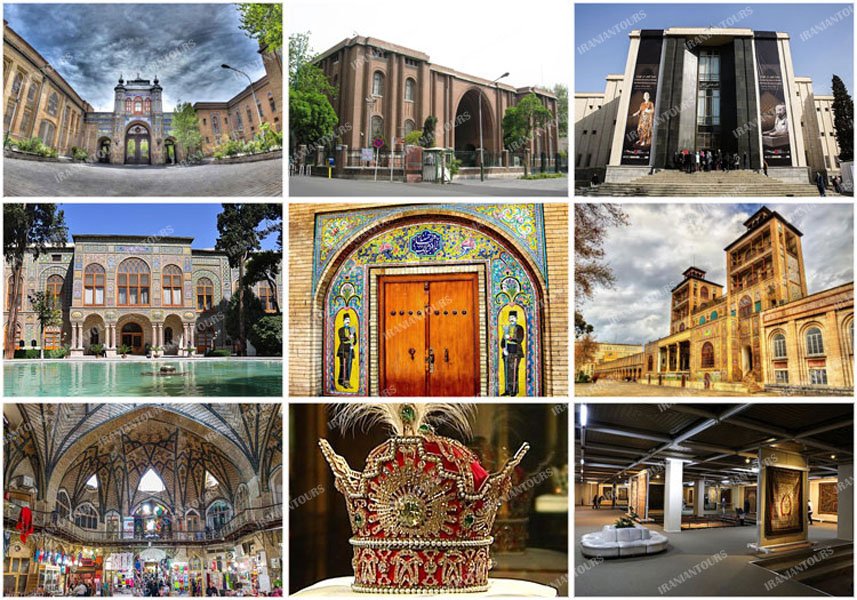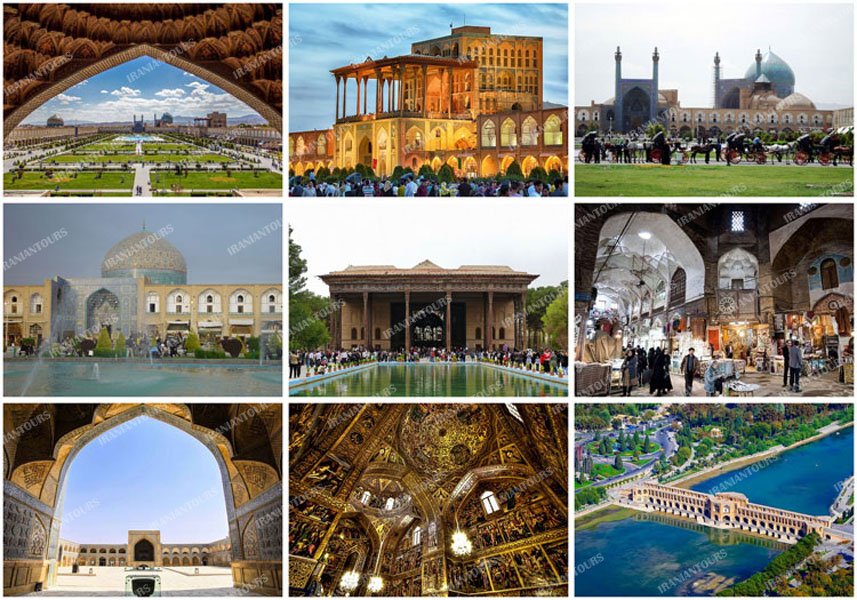- 5
- Tehran
- €595.00
- Sat., Mon.

Home » MT82 : Persia in Depth (intensive)









– Multi-day tour group sizes are 6-12 persons.
– Smaller or private tours can be still operated with 25-35% surcharge on published prices.6
"*" indicates required fields
The tour starts in Bagh-e-Melli, formerly known as the Parade Square, where we can see some landmark buildings dating back to Reza Shah’s reign (early 20th century). The National Museum is next, where the rich 7000+ year history of Iran is on display with a unique collection of chronologically ordered archaeological findings. UNESCO World Heritage site of Golestan Palace comes next where the Qajar (18-19th century) headquarter of the country can be seen. We continue the tour with a visit to the busy Grand Bazaar of Tehran, followed by an unforgettable visit to the world-renowned Treasury of National Jewels. The tour finishes at the former US embassy called as the Den of Espionage in Iran after its seizure in 1979 leading to the hostages’ crisis between Iran and the USA.
You will be transferred to Tehran Railway Station for getting on the 1st Class sleeper night train to Kerman. (You can select to fly to Kerman and overnight there at en extra cost)
Arriving in Kerman, we start our day with visiting Jabalieh Dome, or the Rock Dome believed to be constructed during the Sassanid era. We then drive to Rayen to visit the medieval mudbrick Rayen Castle, similar to UNESCO Wolrd Heritage registred Bam Citadel which was destroyed by an earthquake in 2003. Our next stop is in Shahzdeh (Prince) Garden, registered in the UNESCO World Heritage list as a Persian garden. We then visit The Shrine of Shah Nematullah Vali, a renowned mystic and poet, living in the 14-15th centuries. Its tiled blue dome is described as one of the most magnificent architectural masterpieces in old Persia. Rest of the day is dedicated to visiting the Kaluts, magnificent eroded sand formations Lut desert [U] with a claim to being the world’s hottest location. We also visit some oases in this no-man land. Based on your selection, you can return to Kerman or stay the night in a Desert Camp. O/N Kerman or Desert Camp
Our Kerman sightseeing tour starts with Hayati Museum, a live anthropological museum where you can see Kermani artisans and crafts. Next is Ganjalikhan complex, around a square with the same name and consisting of urban elements including a bazaar, a mosque, a bathhouse, a caravanserai, a madrassa (theological school), a water cistern and a coin mint, all built by Ganjali Khan, the governor of Kerman from 1595 to 1621 in the reign of Safavid Shah Abbas I. We then proceed to the minaret-less Jameh Mosque of Kerman, which dates back to the 14th century. We also visit Moshtaghieh Domes, the mausoleum of Mostagh Ali Shah, Qajarid era Sufi leader and musician who was executed because he recited the Quran while playing music. The tour ends at Moayedi Ice-house which is believed to be the largest adobe ice-house in the world, built-in late Safavid era with the function of storing winter ice for use in the summer. After visiting Kerman, we drive to Yazd with a detour to the ancient village of Meymand [U] to visit hand-dug dwellings amid the rocks inhabited for over the last 3000 years. This was how people here have adapted to the aridity of the land and to high temperatures in summers and very cold winters. The trip ends in Yazd after a short stop at Zeinuddin Caravanserai[500km./310miles]. O/N Yazd
Yazd, in the middle of Iran and in a remote desert location, remained largely immune to large battles, including the Mongols’ invasion. It’s a living testimony to the use of limited resources for survival in the desert. We start our program at AmirChakhmagh Complex, where we see Yazd’s landmark facade, a venue for religious ceremonies. We then visit The Water Museum, with a visible qanat running underneath, posing the old art of water management in this arid landscape. Jameh Mosque of Yazd is next with its magnificent portal and minarets. From here, we start strolling in the narrow alleys of The Old Town, renowned for its earthen architecture and windcatchers. Yazd was a refuge for Zoroastrians after the Arab conquest and is still the hub of the country’s Zoroastrian community. We visit a Fire Temple which gives us more information about this ancient religion. The sacred fire of this temple is stated to have been burning since about 470 AD. We then proceed to The Towers of Silence, used until a few decades ago by Zoroastrians for excarnation – that is, for dead bodies to be exposed to carrion birds, usually vultures. Next is Dowlatabad Garden, a Persian garden with a pavilion having the tallest windcatcher of the country. Our tour ends at a Zoorkhaneh, Persian traditional gym, where we can watch Persian traditional sports in action. O/N Yazd
On our drive to Isfahan, we stop in the historical town of Meybod and see the Sassanid Narin castle, one of the oldest castles of Iran, Chaparckhaneh (the old post office) and the Safavid Caravanserai (one of the 999 motels which were built on the order of Shah Abbas). We also visit a pigeon tower, one of the many similar dovecotes in the region which were used for housing pigeons and collecting bird droppings to be used as farming fertilizer. Proceeding towards Isfahan, we also visit the desert town of Naein to see Jameh Mosque of Naein, one of the oldest mosques of Iran, still in its original form. We also visit Pirnia Historical Hous which is now an anthropological museum showing desert lifestyle. Today program ends in Isfahan. [320km./200miles] O/N Isfahan
Iranians claim Isfahan is half the world! One of the largest cities of the world in the 16-17th centuries, and the capital of Safavid dynasty. We start today’s program in UNESCO World Heritage site of Naghsh-e-Jahan Sq., one of the largest city squares in the world, where we will visit Aliqapu Palace (in 6 floors), The Royal (or Imam) Mosque (one of the masterpieces of Persian Islamic architecture), Sheikh Lotfollah Mosque (private mosque of the royal court) and Chehelsotoun (40-columns) Pavilion. We will then stroll through the labyrinth of Qeysarieh Bazaar, starting on the northern side of the square and ending at The Old Jameh Mosque of Isfahan, another UNESCO world heritage site, one of the oldest still standing mosques in Iran. We then visit Jolfa, the Armenian quarter of the city, where we visit Vank Cathedral, a showcase of Christianity in Iran. Our next stop will be on the banks for Zayandeh River, where we can visit several historical bridges, including Siosepol and Khaju, the two most beautiful bridges of the city. The tour ends with a walk on Charbagh Street, literally the four gardens, a historical street in the heart of Isfahan. O/N Isfahan
On a long drive to Shiraz, we stop in Pasargadae(U), visiting the tomb of Cyrus the Great and remains of the first capital of the Achaemenid Empire. Another hour drive takes us to Naghsh-e-Rostam, a necropolis for Achaemenid kings and a collection of Sassanid rock reliefs. Before arriving in Shiraz, we will have a long stop in Persepolis(U) to visit the magnificent remains from the ancient world in this 2500 years old ceremonial complex used for celebrating Nowruz, the Persian new year at the spring equinox during the Achaemenid Empire. Today’s program ends with a short stop at the Quran Gate. Travellers passing underneath this gate were believed to receive the blessing of the Holy Book on their trip. [480km./300miles] O/N Shiraz